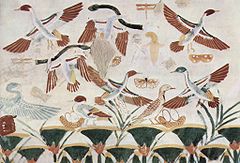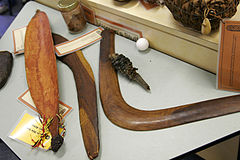Throwing wood

The boomerang is an old hunting rifle of hunter-gatherers . Even monkeys occasionally throw sticks or hard fruit down from trees to drive off approaching predators. Hence it is believed that the throwing stick is an even older throwing weapon than the spear .
General
Throwing wood, originally used as a defense weapon or to knock down unclimbable fruits and nuts, was at some point also used as a hunting weapon.
The throwing wood is particularly suitable for hunting birds. The wood, which rotates in flight, can stun the bird if hit on the head or, if hit on the wings, prevent it from flying away through temporary paralysis or breaking bones and thus secure the prey.
The hit zone of the rotating throwing stick is significantly larger than that of a spear, a great advantage for smaller targets such as birds. However, the javelin has a higher hit effect, so that you can shoot larger game with it.
Australia
Experienced throwers can throw a hunting boomerang up to 100 meters. These hunting boomerangs were also used by the Australian natives as a digging stick , rhythm instrument or percussion weapon .
The only one of the many languages of the Aborigines , the original inhabitants of Australia , used word Boomerang / Boomerang specified therein both the boomerang for hunting (hunting boomerang / Hunting Boomerang) and the returning boomerang (Sports boomerang / Returning Boomerang). A boomerang could weigh up to 2 kg and be 1.30 meters long.
See also
literature
- Felix von Luschan : The throwing wood in Heu-Holland and in Oceanien . In: Festschrift for Adolf Bastian on the occasion of his 70th birthday on June 26, 1896 . Reimer, Berlin 1896, pp. 131–155.
- Thomas Stehrenberger: A throwing wood from the Neolithic settlement Arbon in: Archeology in Switzerland , Vol. 20 (1997), Issue 2, pp. 54–56, ISSN 0255-9005 .
Web links
- Aboriginal technology
- Drawing of a woomera . In: Robert Baden-Powell : Boy Scouts Beyond the Seas. "My World Tour" . Pearson Books, London 1913.
